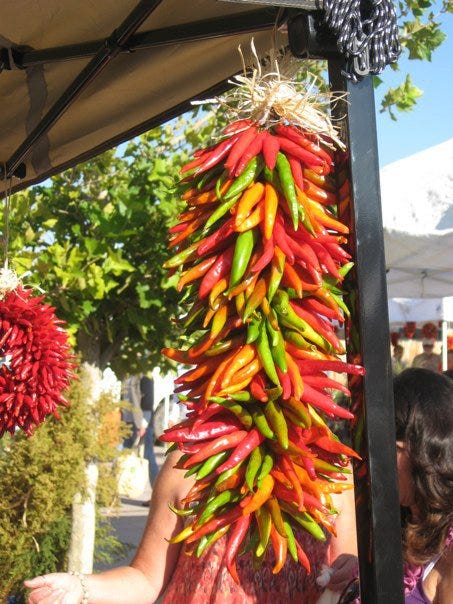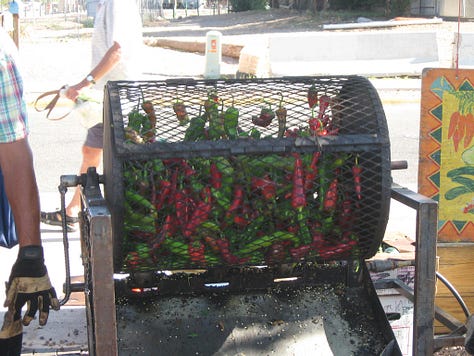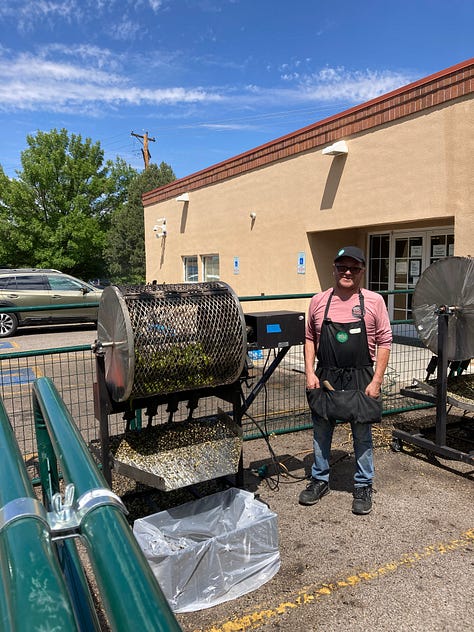Welcome to Postcards from New Mexico! Three Sundays a month, I share beauty, stories, and culture from this region that has been my home since 2008.
Around late July and into August and September, you’ll start noticing a very distinct aroma wafting around the air of Northern New Mexico. And it usually has its source in the parking lots of grocery stores and shopping centers. Keep heading toward that smell and you’ll soon see large roasting barrels rotating over flames, their insides filled with gorgeous New Mexico-grown green chiles. This is chile roasting time!
Perhaps no plant is more identified with Northern New Mexico culture and cuisine than the green chile. Norteños love it with a passion, and you’ll find it on or in many dishes like enchiladas, burritos, tacos, burgers, and even pie.
The most important things you need to know for your New Mexico chile adventure:
First of all, make sure to spell it correctly! The plant is “chile.” Nothing will mark you more quickly as a tourist than spelling it “chili.”
New Mexico chile is a cultivar group, meaning it’s a variety of the plant that’s been produced through selective breeding over time. In this case, what we now know as the New Mexico chile has come down to us through the agricultural practices and choices of Indigenous Pueblo and Hispano farmers. These plants were then used by horticulturist Fabian Garcia to develop the modern New Mexico chile pepper in 1894.
Did you know New Mexico actually has an official state question? "Red or green?" is the question you’ll hear when your server takes your order. You can answer with “red,” or “green,” but also “Christmas” which gets you both.
All New Mexico chiles start out green; the only difference is that chiles that are allowed to ripen longer on the plant turn red.
Which one is hotter? The official answer is that red is hotter (and also sweeter) because it’s more ripened and therefore contains more capsaicin, the heat-producing element. My subjective take is that the two have a different kind of heat. When you first taste green chile, you may think, “Ah, that’s not so bad!” And then about 30 seconds later you feel like your mouth is on fire. With red chile it tends to happen the other way around – the heat comes first and wears off quickly. But also know it depends on the crop that year and the way it was prepared. So there really is no standard answer! You just have to try them yourself and see…
There’s a reason why it hurts so good to partake in a really hot chile. That “pain” that our bodies perceive when eating heat-producing foods like chiles provokes the release of endorphins and dopamines, creating a kind of pain/pleasure cycle. We might experience a sense of relief in that release, and even euphoria.
New Mexico chile is divine, in my humble opinion! Once you get hooked on it, you’ll need to come back over and over to get your fix. Here are my two best tips if you want to eat like the locals but are feeling a bit cautious:
Ask for it on the side. That way you can choose how much you want on your dish, which is way better than discovering your mouth is on fire and your entire enchilada is drenched in chile and therefore rendering it inedible to you.
If you get the mouth-on-fire sensation, whatever you do DO NOT drink water! I know this seems counterintuitive, but the water will spread the heat, not put it out. Instead, take a drink of something like milk that can coat your mouth, or take a bite of a sopapilla or something else starchy like rice. That will help!
See more “Local’s Tips” below on how to find some of the best chile in Northern New Mexico.



Local’s Tips…
Become a paid subscriber and access this section! Paid subscribers enjoy these benefits:
A genuine snail-mail postcard from New Mexico!
Access to the “If you go/Local’s Tip” section of certain posts, where you’ll find valuable information to enhance your next journey to Northern New Mexico.
In acknowledgement of living on un-ceded Tewa lands, 10% of your subscription fee is donated to Native-led nonprofits doing good work in this region.





